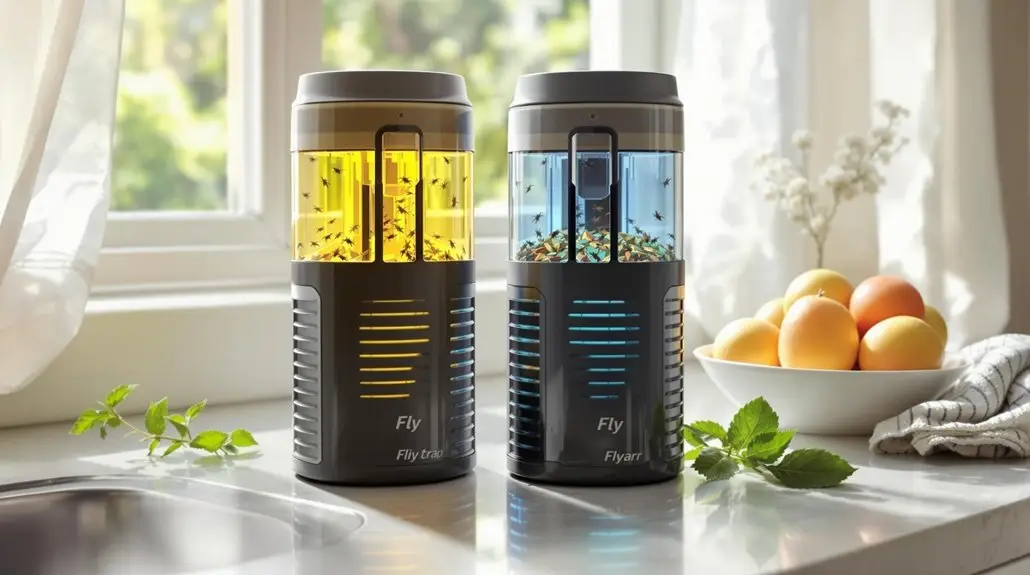To effectively manage flies, you need to focus on sanitation and preventive measures. Keep trash cans covered tightly and remove food waste daily. Use fine mesh screens on doors and windows to block entry, and seal any cracks around your space. Regularly monitor fly populations, as identifying species helps tailor your strategies. Employ both non-chemical methods, like traps and fans, and chemical options, like insecticides, when necessary. Finally, eliminate breeding sites by cleaning daily and managing manure properly. These principles create a cleaner environment, reducing fly presence considerably. There’s much more to explore for success in your fly control efforts.
Key Insights
- Implement Integrated Pest Management (IPM) to combine monitoring, sanitation, and targeted control techniques for effective fly management.
- Regularly clean and maintain facilities to eliminate breeding grounds, including manure, food waste, and standing water.
- Use physical barriers like fine mesh screens and automatic doors to prevent fly entry into buildings.
- Conduct regular fly population assessments to identify species and adjust control measures accordingly.
- Utilize a mix of non-chemical and chemical control techniques, including traps, sprays, and larvicides, while rotating insecticides to prevent resistance.
Sanitation and Manure Management
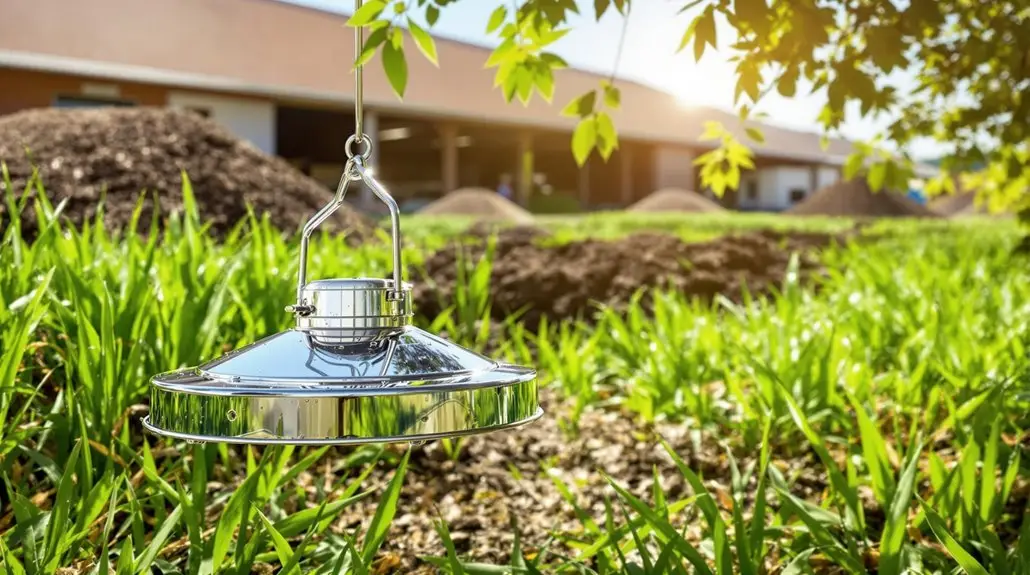
To effectively manage flies, you should regularly practice proper sanitation and manure management. Start by keeping trash cans clean and tightly covered to prevent fly breeding. Remove any garbage containing food waste before nightfall, or tie a knot in the plastic liner to seal it. Use plastic liners in all waste receptacles, and make sure to seal them before disposal.
Regularly clean waste receptacles and dumpsters using a high-pressure stream of water or a brush with soapy water. To eliminate odors, rinse them with a mild solution of borax or baking soda and water. House flies often breed in decaying organic matter, making it crucial to maintain cleanliness. Implementing eco-friendly solutions can significantly enhance your pest control efforts.
When it comes to manure management, never allow manure, grass clippings, or decaying organic matter to accumulate. Store manure in closed, rodent-proof dumpsters or garbage cans outside and away from doors. Promptly remove any pet feces and place them in sealed plastic bags.
Avoid washing garbage cans where the rinse water might drain into the soil, as this can create breeding grounds for flies. Regularly check areas for maggots and dispose of any infested material in sealed plastic bags.
For food waste disposal, always drain food wastes before placing them in a plastic bag. Store food in the refrigerator, freezer, or insect-proof containers.
Remove trash, debris, and food from employee lockers or breakrooms multiple times throughout the day. By following these steps, you’ll create a cleaner, more inviting environment that not only reduces fly populations but also fosters a sense of pride in your space.
Non-Chemical Control Strategies
When it comes to managing flies, preventive physical barriers and maintaining cleanliness are key strategies. You can install fine mesh screens to keep flies out and regularly clean areas where flies breed. Implementing effective manure management practices, such as regular barn cleaning and reducing manure accumulation, significantly contributes to lowering fly populations. Additionally, practicing Integrated Pest Management (IPM) can enhance overall fly control efforts by combining various strategies for more effective results.
Preventive Physical Barriers
Implementing preventive physical barriers is essential for protecting horses from bothersome flies. By using fly masks, you can shield your horse’s face and eyes, keeping them comfortable and secure. Fly sheets are another great option, covering their bodies to prevent flies from landing on their skin. Additionally, it’s important to focus on good housekeeping to maintain a clean environment that minimizes fly breeding. Regularly applying pest control measures can further enhance the effectiveness of these barriers.
Don’t forget about fly boots or leg wraps to protect those sensitive legs, and consider fly wraps around their belly and back for added protection. Ear nets can also help keep flies away from your horse’s ears.
For your barn or stable, installing nets and screens on doors and windows is a must. You can also use electric fans or air curtains at entry points to deter flies effectively.
Setting up traps outside draws flies away from the horse areas, while residual premise sprays can help keep barn walls fly-free.
Additionally, environmental modifications like keeping grass short, eliminating standing water, and removing overgrown vegetation can greatly reduce fly attraction.
Sanitation and Cleanliness Practices
Maintaining a clean environment is essential in managing flies around horses. By adopting effective sanitation and cleanliness practices, you can greatly reduce fly populations and create a more comfortable environment for both your horses and everyone involved in their care.
Here are some key practices to keep in mind:
- Remove manure daily from high-risk areas to limit fly breeding.
- Store feed in sealed containers to prevent attracting flies with spilled or spoiled food. Additionally, maintaining a clean environment helps deter other pests, such as rodents and cockroaches.
- Clean under equipment and around drains regularly to eliminate organic debris and moisture. Additionally, ensure that decaying vegetable matter is removed promptly to further decrease fly breeding sites.
- Empty trash bins frequently and make certain lids are tight-fitting to minimize odors.
- Monitor and clean spillages daily to prevent fly infestations.
Chemical Control Techniques
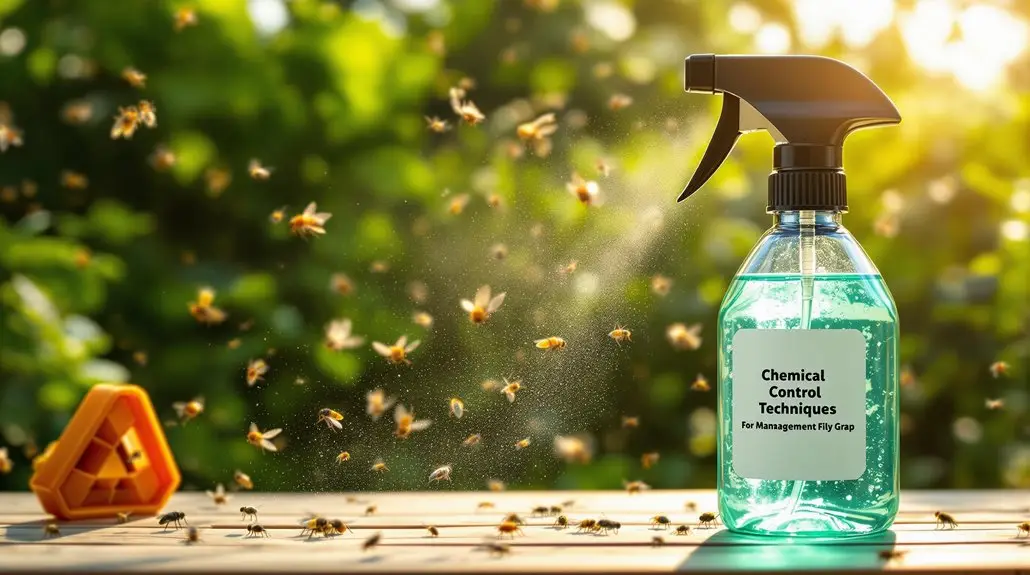
Chemical control techniques are vital for effective fly management in various environments. When you integrate insecticides into your fly control plan, you greatly reduce the initial fly burden. These insecticides often come in a blend with sugar and pheromone attractants, making them more effective. Familiar options include permethrin and pyrethrins, which can be part of a solid biosecurity program. Additionally, it is important to recognize that flies are commonly found in unsanitary areas, which can increase the likelihood of infestations.
Don’t forget about larvicides; they target fly larvae directly. Apply them as sprays or granules on manure or litter, ideally two weeks after placing birds in the house. Timing is essential, and you should limit treatments to avoid resistance.
Rotating insecticides is another important tactic. By switching to products with different modes of action every 6-9 weeks, you can prevent flies from developing resistance and guarantee your methods remain effective. This not only protects your current flies but also aids in long-term management.
Supplementary chemical controls can enhance your efforts, too. Use premise sprays around your barn’s perimeter to repel flies and residual sprays on surfaces where they gather.
For immediate results, aerosol fly sprays can provide quick knockdowns, though they lack lasting effects. Spot treatments in high-activity areas can also be very effective.
Monitoring Fly Populations
To effectively manage fly populations, you need to accurately identify the fly species present in your area. Regular population assessments will help you track changes over time, allowing for timely interventions. Additionally, implementing localized monitoring reveals specific breeding areas, allowing for targeted control measures.
Identification of Fly Species
Identifying fly species is essential for monitoring their populations effectively. By knowing which species you’re dealing with, you can tailor your management strategies to be more effective.
Here are some key features to ponder:
- Wing Morphology: Look at the shape and size of wings, especially in blow flies.
- Color and Patterning: Overall color and specific patterns can help identify fruit flies.
- Eye Placement: Take note of eye shapes—house flies have forward-facing, goggle-shaped eyes.
- Body Shape and Hair: Observe the body shape and the presence of hair; shiny bottle flies differ from fuzzy drain flies.
- Genitalia: Male genitalia can be vital for identifying blow fly species.
Additionally, understanding the importance of blow flies in forensic science can aid in recognizing their role in various environments.
Using both morphological and molecular methods can enhance your identification accuracy. Techniques like DNA barcoding and COI gene sequencing can help you differentiate species, especially when physical traits are similar.
Regular Population Assessments
Regular population assessments are essential for effective fly management, enabling you to track changes in fly numbers over time. By employing various monitoring techniques, like indoor adhesive paper traps, you can easily count flies weekly and observe trends.
For outdoor areas, use open-air Scudder grid counts and adhesive paper catches to analyze fly populations accurately. Systematic sampling is crucial for studying stable fly biology and ensuring accurate population counts.
It’s vital to conduct these assessments regularly, especially from April to October, as this helps you establish typical fly numbers and anticipate peak periods. Remember to avoid counting during adverse weather conditions—cold, windy, or wet days can skew your results.
Data analysis is key. Compare trends at your location with those at nearby sites to identify potential breeding areas.
Utilize multiple traps to assess population density effectively, and separate traps by 1.5-2.0 km to account for spatial variations.
Structural Defenses Against Flies
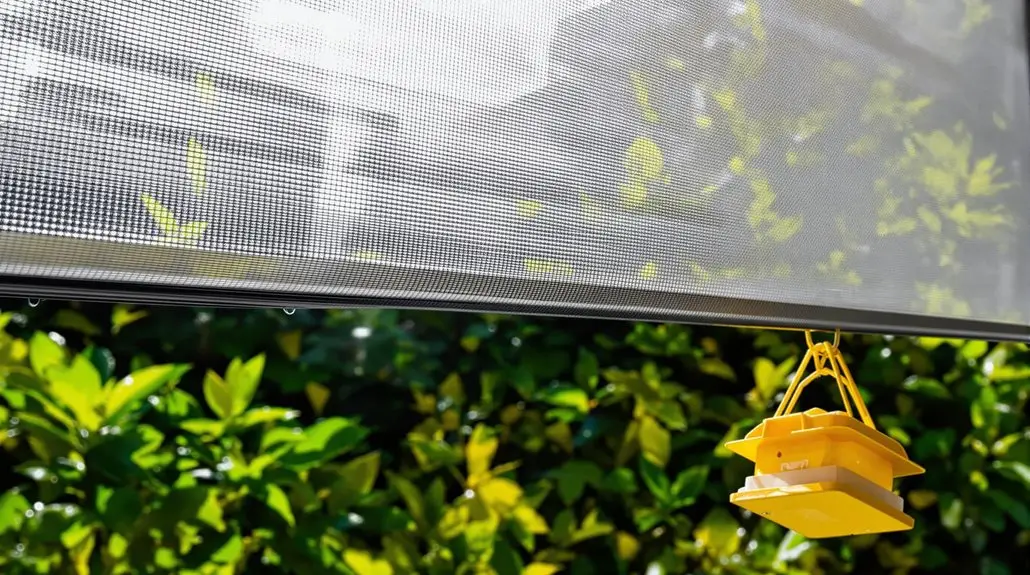
How can you effectively keep flies out of your space? Implementing structural defenses is key to creating an environment that’s not just fly-free but also welcoming for you and your guests.
By focusing on a few essential modifications, you can greatly reduce fly entry and make your space more enjoyable. Here are some strategies to reflect upon:
- Install screens on doors and windows to keep flies out.
- Seal cracks and openings around doors, windows, and vents to block access.
- Use automatic door closers and air curtains to minimize fly entry.
- Employ tight-fitting lids on trash cans and keep them away from entrances.
- Implement fly traps in strategic locations, particularly in kitchens.
Regularly checking your trash disposal practices is vital, as flies are attracted to decaying organic matter, making it essential to manage waste effectively.
Taking these steps not only protects your space but also fosters a sense of community comfort. Implementing these changes aligns with a commitment to organic pest control practices that promote a healthier environment.
A well-maintained environment shows you care about your surroundings and those who share it with you. Regularly check your screens for any holes or tears, ensuring they’re in good condition.
Preventive Measures and Timing
Effective fly management hinges on preventive measures and timing. By implementing strategic practices, you can create an environment that’s less welcoming to flies, ultimately benefiting both your livestock and your peace of mind. Regularly removing manure, maintaining its dryness, and ensuring proper disposal are essential steps. You’ll want to monitor for leaks in manure holding areas, ensuring good ventilation to keep moisture at bay. Additionally, managing manure moisture below 50% water content is crucial in minimizing fly attraction.
Here’s a handy table summarizing key preventive measures and their timing:
| Preventive Measure | Timing |
|---|---|
| Remove manure daily | Throughout the year |
| Monitor fly activity | Twice weekly during peak season |
| Adjust strategies seasonally | At the start of each season |
Starting your fly control program early in the season is significant. You should begin before the warm weather sets in, as this is when flies become active. Monitor fly populations regularly during peak seasons from April to October, adjusting your strategies based on weather conditions.
In addition to manure management, pay close attention to feed and water storage. Store feed securely, clean up spills daily, and fix any leaks to eliminate potential breeding sites. Regular cleaning and proper trash management also play essential roles in maintaining an environment that discourages flies. By adopting these preventive measures and timing your actions wisely, you’ll foster a healthier, fly-free space for everyone involved.
Effective Use of Fly Traps
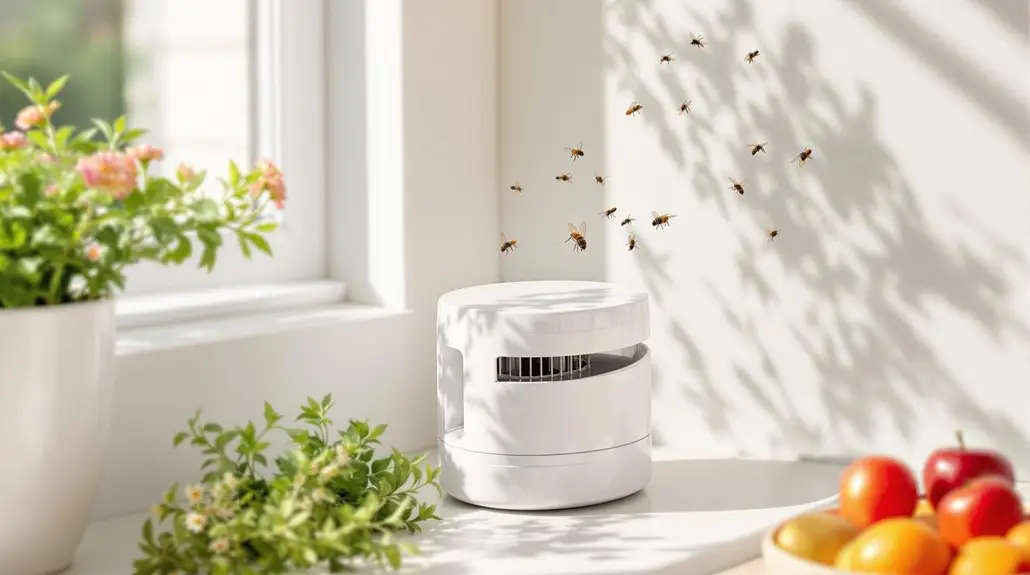
Utilizing fly traps consistently can greatly enhance your fly management efforts. By selecting the right traps and placing them effectively, you can considerably reduce the fly population around your home.
Here are some key points to take into account when employing fly traps:
- Choose the Right Trap: Depending on your environment, choose from glue traps, disposable bag traps, insect light traps, reusable jug traps, or sticky window traps.
- Strategic Placement: For outdoor traps, hang them at least 20 feet away from living spaces. Indoors, position them near windows or food sources for best results.
- Regular Maintenance: Keep reusable traps clean and replace bait as needed. Disposable traps should be replaced frequently to maintain their effectiveness.
- Secure Options: Opt for non-toxic traps that are suitable to use around kids and pets, ensuring a worry-free environment for your family.
- Monitor Effectiveness: Pay attention to how many flies each trap catches. If a trap fills up quickly, think about placing additional traps in the area.
Managing Breeding Grounds
Fly traps can greatly reduce adult fly populations, but managing breeding grounds is equally important to long-term control. To effectively tackle the issue, you need to identify and eliminate common breeding sites. Spoiled feed, bedding, decaying organic matter, and manure are hotspots for flies.
Pay special attention to areas around waterers, feeding aprons, and manure storage—these spots can become breeding grounds if not cleaned regularly.
Make it a habit to remove manure from high-risk areas like cattle pens and calf housing. Drying manure to less than 50% moisture content is essential; this inhibits fly reproduction.
Guarantee good ventilation in manure holding areas to aid drying, and address any sources of excess moisture, like leaks or condensation. When spreading manure as fertilizer, do it thinly for rapid drying.
Don’t forget about maintaining clean facilities. Daily disposal of dead birds, cracked eggs, and feed spillages will greatly reduce breeding sites.
Keep your entry and break areas tidy to prevent flies from spreading indoors. Also, clear grass, weeds, and clippings near your facility’s perimeter to eliminate outdoor resting spots.
Lastly, consider structural adjustments. Proper drainage in feedlots and around waterers is critical.
Implementing slopes in debris basins helps prevent water accumulation. By taking these steps, you’ll create an environment that’s far less inviting to flies, guaranteeing you and your community can enjoy a more comfortable space.
Best Practices for Fly Control
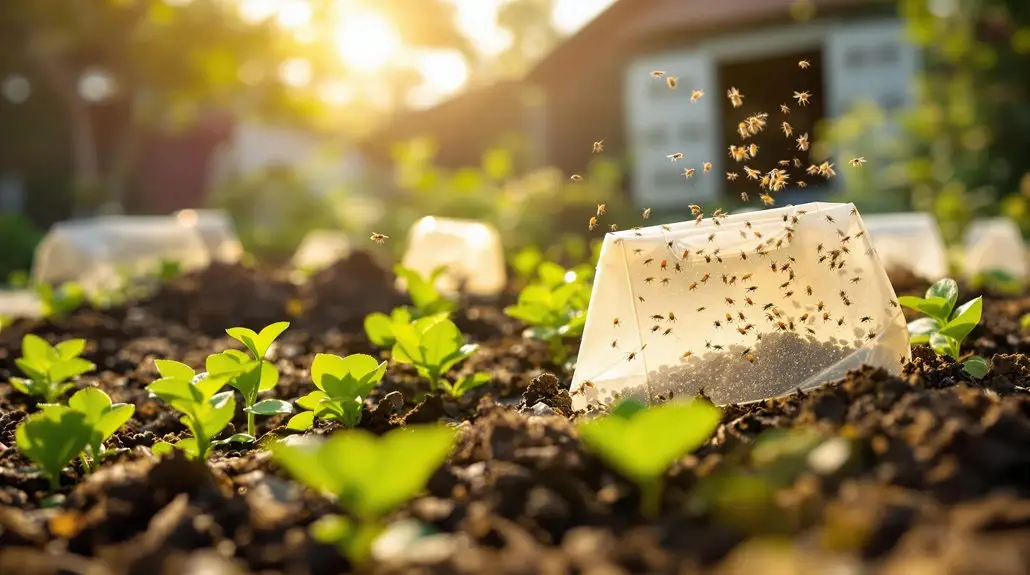
Implementing best practices for fly control starts with maintaining a clean environment. Flies thrive in dirty spaces, so taking proactive measures can greatly reduce their presence in your home or barn. Here are some essential practices you should follow:
- Regularly remove animal wastes, garbage, and decaying matter.
- Use tight-fitting lids on garbage cans, and clean them often.
- Eliminate standing water and keep areas dry.
- Mow your lawn and trim overgrown vegetation.
- Clean up feed spills daily to deter flies.
In addition to sanitation, creating barriers can prevent flies from entering your space. Tight-fitting window screens and sealed cracks are important. Consider installing automatic doors or screen openings to further reduce fly access.
Don’t forget about chemical control methods. Using residual sprays like permethrin outdoors and aerosol sprays indoors can help manage flies effectively. You can also use insecticide baits and feed additives designed to disrupt fly development in manure.
Lastly, trapping and monitoring are essential. Set up sticky traps at entry points, and consider liquid baited traps outdoors.
Regularly check for adult and larval fly populations, especially during warmer months, and train your family or staff in monitoring techniques.
Frequently Asked Questions
What Are the Most Common Fly Species Found in Barns?
In barns, you’ll commonly encounter house flies, stable flies, face flies, and horse and deer flies.
House flies are grayish-black and love to feed on decaying matter.
Stable flies bite and can be a nuisance to livestock.
Face flies hang around animals, feeding on secretions, while horse and deer flies deliver painful bites.
Understanding these species helps you create a more comfortable environment for both animals and yourself in the barn.
How Do Weather Conditions Affect Fly Populations?
Weather conditions can really make or break fly populations!
You’ll see that warm temperatures get those bothersome flies buzzing with activity, speeding up their life cycles and egg-laying.
Rainfall also plays a huge role; just a little moisture can lead to a fly explosion!
Pay attention to seasonal changes, too—hot springs boost their numbers, while chilly winters can keep them in check.
Understanding these patterns helps you stay ahead of the game!
What Role Do Animals Play in Attracting Flies?
Animals play an essential role in attracting flies, mainly through their secretions and wastes. When you have cattle, their tears, saliva, and manure create ideal breeding grounds for flies.
These pests are drawn to the protein in these secretions, making your livestock more susceptible to infestations. By keeping your animals and their environment clean, you can greatly reduce fly attraction and promote a healthier, more comfortable setting for your cattle.
How Often Should I Clean and Maintain Fly Traps?
Did you know that a well-maintained fly trap can catch up to 20 times more flies than a neglected one?
To keep your traps effective, clean them every few weeks, especially during peak fly season. Remove any dead flies and debris to guarantee they stay attractive.
Regular maintenance not only enhances performance but also creates a welcoming environment for your plants and guests.
You’ll feel proud of your trap’s effectiveness and your care for it!
Are There Natural Predators That Help Control Fly Populations?
Absolutely, there are natural predators that can help control fly populations!
Parasitoid wasps, for instance, lay their eggs inside fly pupae, preventing flies from emerging. They’re harmless to you and your pets, and they reproduce quickly, keeping the predator population strong.
You can also find spiders and other insects that target earlier stages of flies.
Defend Your Space Naturally: Eliminate Flies with NaturePest Holistic Pest Control!
In the battle against flies, NaturePest Holistic Pest Control provides you with the essential tools to turn the tide. By embracing sanitation, monitoring populations, and deploying traps, you can create a fortress against these pests. Think of your efforts as weaving a protective net; each strand strengthens your defense and keeps flies at bay. Remember, consistency and vigilance are key. With NaturePest’s holistic principles, you’ll not only manage fly populations but also create a healthier environment for yourself and those around you. Take action today—join the NaturePest community and protect your space from unwanted pests!

